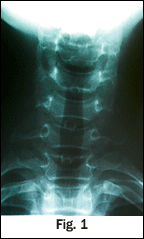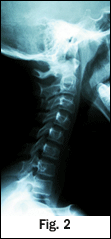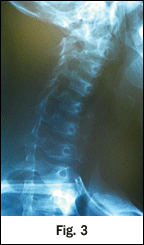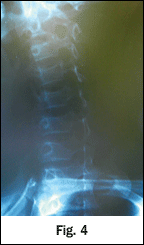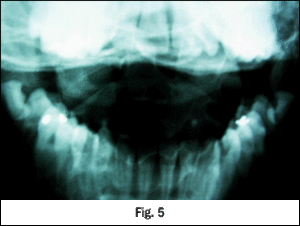Abstract
Objective: A single case study involving a 14-year-old male, in which no adverse effects to manual treatment were documented. A second objective was to provide clinical documentation of an informed consent and management protocols utilized in a group chiropractic setting.
Method: During an eight-week period, a treating chiropractor practicing within a chiropractic group practice treated a 14-year-old Stickler patient who was not made markedly worse during or immediately after chiropractic adjustments. The details of this case are reported. In 1998, The Advisory Commission on Consumer Protection and Quality in the Health Care Industry was created by the U.S. president to monitor "changes occurring in the health care system and recommend such measures as may be necessary to promote and assure health care quality and value, and protect consumers and workers in the health care system."1 The commission developed a "Consumer Bill of Rights" in health care and provides the president with recommendations to enforce those rights at the federal, state, and local level.
Consumers have the right and responsibility to fully participate in all decisions related to their health care that includes chiropractic. Consumers who are unable to fully participate in treatment decisions have the right to be represented by parents, guardians, family members, or other conservators. This case provides an informed consent utilized within the case management at which time the parent and minor both participated in asking questions on the chiropractic care plan.
Conclusion: Relationships between consumers and health care professionals are most rewarding and likely to result in positive outcomes when they are characterized by open communication and active participation of patients in the treatment process. Patient participation in treatment is an essential part of compliance, and compliance improves the effectiveness of care and treatment.
Introduction
Stickler syndrome is a relatively common, autosomal dominate condition with generally severe, progressive myopia, progressive sensoineural hearing loss, cleft palate, hyper- and hypomobility of the joints, and typical mandibular hypoplasia. The known defect is the type II collagen (the protein substance of the white fibers of the skin, tendon, bone, cartilage and all other connective tissue). In some families, chromosome 12 has the defect.
Case Presentation
This 14-year-old young man had complained of neck pain on his left side over the past several months after he was accidentally struck on the playground on the side of his neck. He suffered ongoing pain in the anterior neck and consequently experienced pain when looking upward and turning to his left. He presented for a chiropractic specialty consultation to this facility from his PCP. He had undergone several previous cleft palate surgeries with good reconstruction. He never had undergone any administered sessions of cervical manipulation.
On the first spinal manipulation, he experienced a sudden increase in cervical tone of the left SCM, and reported a sudden decrease in pain with motion. No new pain with radiation into or down his left arm or with numbness in his fingers developed, nor did he develop any weakness in his left hand. He was seen subsequently for 12 conservative measures; 50 percent of the time he received spinal adjustments and he did improve. There was an indication of a relative contraindication to CSMT based upon the disease process. He previously had undergone radiological imaging, which revealed an antalgic list (Fig. 1), sigmoid-type curve and loss in cervical lordosis and a slight segmental flexion and anteriolisthesis (Fig. 2), consistent to a whiplash or CAD injury presentation. Cervical oblique (Fig. 3-4) failed to demonstrate any cervical stenosis. Open-mouth odontoid or dens (Fig. 5) failed to demonstrate any developmental deficiencies of the cervical spine, i.e., agenesis or odontoid hypoplasia. A low-force technique mode was chosen and discussed with the family. At the conclusion of care, the patient had experienced a complete recovery of his acute pain state.
The incidence of complications after CSMT has been estimated in the literature. The most commonly reported complication is vertigo, occurring at a rate of 1,218 per 1.53 million manipulations, with diminished consciousness occurring in 10 per 1.53 million procedures, loss of consciousness in 12 per 1.53 million procedures, and radicular deficits in 11 per 1.53 million manipulations.2 In order to ensure consumers' right and ability to participate in treatment decisions, chiropractic professionals should provide patients with easily understood information and the opportunity to decide among treatment options consistent with the informed consent process. Specifically, discuss all treatment options with a patient in a culturally competent manner, including the option of no treatment at all. Ensure that patients with disabilities have effective communications with members of the health system in making such decisions. Discuss all risks, benefits, and consequences to treatment or no treatment. Give patients the opportunity to refuse treatment and to express preferences about future treatment decisions. Abide by the decisions made by patients and/or their designated representatives, consistent with the informed consent process.3
An example of a chiropractic informed consent form is presented below. The informed portion is the clinical documentation and the written permission obtained by patient, or in the case of a minor, the legal guardian.
|
Typically, the method of chiropractic adjustments is recommended in the portion of the patient treatment plan. Typical chiropractic adjustment modes that doctors of chiropractic are most commonly trained in include: HV thrusts without toggle recoil, HV thrusts with toggle recoil, LV thrusts without toggle recoil, LV thrusts with toggle recoil, sustained force, blocking techniques, manually assisted mechanical thrusts, mechanically assisted manual thrusts, neurological reflex techniques, LV controlled vector force. It is suggested that these modes be documented, rather than simply naming a technique mode, for ease and clarification of treatment goal.
In this case presentation, a HV (low-force) without toggle recoil was chosen for the adjustment mode, and physiotherapeutic exercise for restoration of cervical pain-free range of motion; PNF interactive neurological re-education for the cervical spine was chosen for the muscle asymmetry. Frequency and duration: 2-3 times per week for 4-6 weeks.
References
- President's Advisory Commission on Consumer Protection and Quality in the Health Care Industry. Consumer Bill of Rights and Responsibilities. Chapter Four - Participation in Treatment Decisions. www.hcqualitycommission.gov/cborr/chap4.html.
- Dvorak J, Kranzlin P, Muhlemann D, et al. Musculoskeletal Complications. In: Haldeman S (ed): Principles and Practice of Chiropractic. Norwalk, CT: Appleton and Lange, 1992, pp 549 578.
- Wu WC, Pearlman RA. Consent in medical decision-making: the role of communication. J Gen Intern Med 1988;3:9-14.
Nancy Molina, DC
San Juan Capistrano, California
Click here for previous articles by Nancy Martin-Molina, DC, QME, MBA, CCSP.






